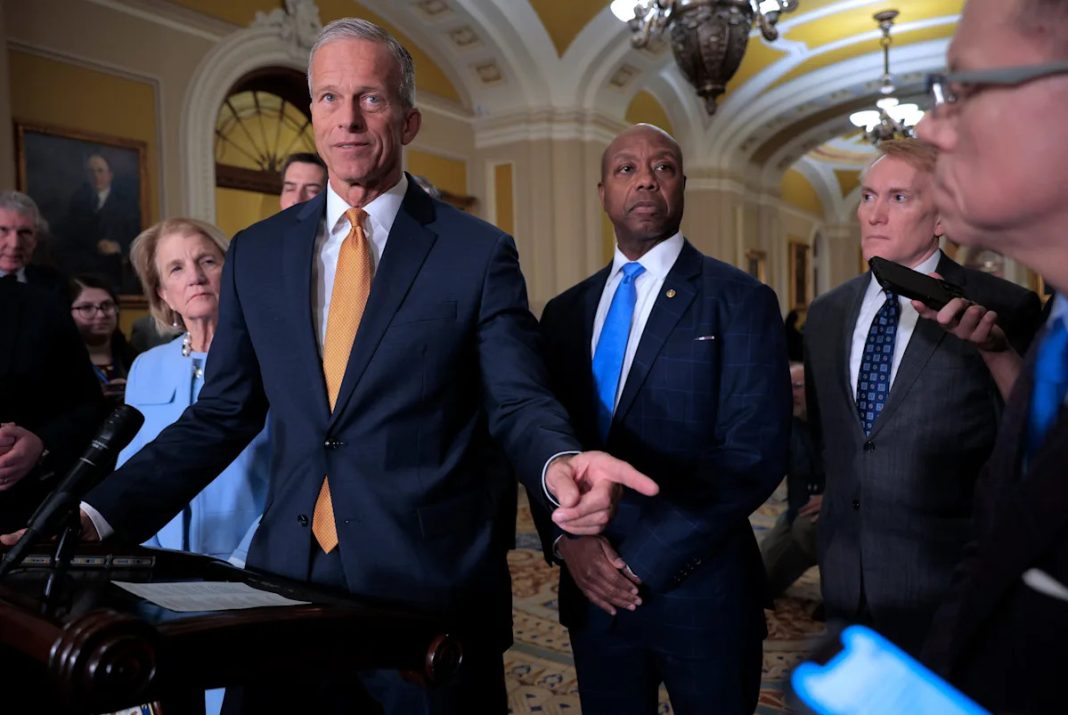WASHINGTON – The government shutdown is getting worse, and members of Congress are starting to realize it.
That’s why they’ve begun proposing more standalone bills that, while not capable of fully reopening the government, would address the crisis’ biggest pain points – from an impending lapse in funding for food stamps to widespread concern over military pay.
Rank-and-file lawmakers, both Republicans and Democrats, seem to increasingly acknowledge that at some point soon, something’s got to give.
“We can work out a lot of the issues we have,” said Sen. Mike Rounds, R-South Dakota. “We don’t need to have the rest of government held hostage.”
“I really don’t think the people at home right now who are about to lose their SNAP benefits, (whose) health care premiums are doubling, tripling, quadrupling … I don’t think those people are thinking about Democrats or Republicans,” said Sen. Raphael Warnock, D-Georgia. “They’re trying to figure out how to make their families whole.”
Still, lawmakers haven’t managed to pass anything to ease the shutdown pressure on Americans. Several measures from both sides of the aisle – including bills that would pay federal workers and save safety-net programs from running out of money even as the government stays shuttered – have failed or are expected to fail, at least until party leaders change their minds.
Senate Majority Leader John Thune (R-SD) calls on reporters with Sens. Shelley Moore Capito (R-WV) (L), Tim Scott (R-SC) and James Lankford (R-OK) following the weekly Senate Republican policy luncheon on the 28th day of the federal government shutdown.
“That is just the wrong way to do this,” Senate Majority Leader John Thune, R-South Dakota, said Tuesday. “The way to approach this is just to reopen government.”
Vice President JD Vance met the same day with Senate Republicans to talk in part about the shutdown, though lawmakers said the discussion veered primarily into frustrations about President Donald Trump‘s plans to import more beef from Argentina.
The president, meanwhile, is on a multi-country trip in Asia and isn’t scheduled to return until Thursday.
Read more: Republicans are beefing with Trump over beef
USDA secretary says contingency funds aren’t enough to cover SNAP

Brooke Rollins, President and CEO of the America First Policy Institute speaks during a rally for Republican presidential nominee and former U.S. President Donald Trump at Madison Square Garden, in New York, U.S., October 27, 2024. REUTERS/Andrew Kelly
Agriculture Secretary Brooke Rollins said her department lacks the $9.2 billion to pay for SNAP benefits in November after a coalition of 25 Democratic-led states sued the Trump administration over plans to end the food-stamp program beginning Nov. 1 amid the government shutdown.
“We don’t even have close to that in contingency funding,” Rollins said in a Tuesday afternoon interview on CNN. “We’ve got to get this government open.”
Plaintiffs in the lawsuit argue the USDA is obligated to use funds from its $6 billion in contingency funds to cover SNAP in November, but Rollins has said the emergency money can’t be used for this purpose. The position seems to contradict previous USDA guidance that said the money was available “in the event that a lapse occurs in the middle of the fiscal year.”
Rollins downplayed the guidance, dated Sept. 30, as an “iterative document.” She also said the emergency fund isn’t large enough to cover the shortfall. During the shutdown, Rollins said the department has spent money to open Farm Service Agency offices and pay food and safety inspectors, while also maintaining the SNAP program in October.
“The SNAP program in November costs $9.2 billion,” Rollins said. “We don’t have the legal authority, as of today, to distribute anything less than that through the formulas, etcetera. We’re obviously looking at all of this as we move forward.”
Judge extends block on Trump’s mass layoffs during shutdown

Oct 1, 2025; Washington, DC, USA; National Parks Service workers remove trash from around the Washington Monument on the first day of the federal government shutdown on October 1, 2025.
A federal judge on Tuesday further blocked Trump’s administration from following through on plans to lay off thousands of federal employees amid a nearly month-long partial government shutdown.
During a hearing in San Francisco, U.S. District Judge Susan Illston extended an earlier temporary ruling barring nearly 40 federal agencies from implementing layoffs pending the outcome of a legal challenge by unions that represent federal workers.
About 4,100 employees at eight agencies had been notified that they were being laid off before Illston’s Oct. 16 ruling, the Trump administration said in court filings. White House Budget Director Russell Vought has said that more than 10,000 federal workers could lose their jobs because of the shutdown.
– Reuters
JD Vance says troops will continue to be paid during shutdown

Vice President JD Vance speaks with reporters after meeting with Republican senators on Oct. 28, 2025.
Vice President JD Vance told reporters at the Capitol on Tuesday that military members will receive their next paychecks despite the ongoing government shutdown.
“Will the troops get paid on Friday? Yes,” Vance said, according to reports. “We believe that we can continue to pay the troops on Friday.”
However, the vice president did not provide additional details on what funds the government will use to pay military members. Troops, like millions of federal workers, see their paychecks on the line when the government shuts down.
– Marina Pitofsky
This article originally appeared on USA TODAY: Senators scramble in vain to ease shutdown consequences: Live updates

